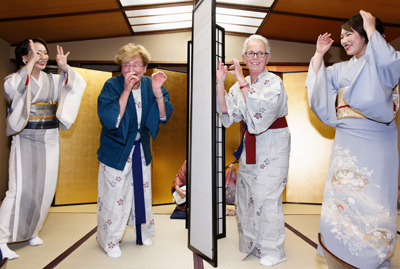
Foreign guests enjoy parlor games with geisha. Ichinoyu was the first ryokan group in Hakone to commercialize set plans with other tourist resources in the vicinity. The plan established in collaboration with geisha enables many foreigners to enjoy Japanese culture at a reasonable price. The program is composed so as to gradually shorten the distance between the foreigners and the geisha. First of all, the geisha perform song and dance on a stage; then they play games together; finally, the party ends with everyone posing together for photos. Other set plans, which contribute to regional vitalization, include harvesting mikan oranges, fishing for pond smelt, crafting marquetry, and visiting art galleries.
What do Japanese guests want when they visit a ryokan? In all likelihood, it is not the laying of futon that they want, nor complimentary cups of tea, nor a dinnertime greeting from the proprietress. As Mr. Yago said, “We realized that what they want is to be able to drink tea whenever they like and to bathe in the hot springs as often as they like. And it seems to us that Ichinoyu’s style matches the feelings of foreigners. From Ichinoyu’s perspective, we were tackling the issue of ‘productivity,’ but our guests saw it as ‘convenience.’ Our efforts to raise productivity have resulted in an improvement in customer satisfaction.”